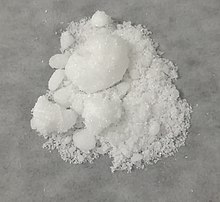 | |
 | |
| Names | |
|---|---|
| IUPAC name Cadmium(II) bromide | |
| Other names Cadmium dibromide | |
| Identifiers | |
| |
3D model (JSmol) | |
| ChemSpider | |
| ECHA InfoCard | 100.029.241 |
| EC Number |
|
PubChem CID | |
| RTECS number |
|
| UNII | |
CompTox Dashboard (EPA) | |
| |
| |
| Properties | |
| CdBr2 | |
| Molar mass | 272.22 g/mol |
| Appearance | white solid |
| Density | 5.192 g/cm3, solid |
| Melting point | 568 °C (1,054 °F; 841 K) |
| Boiling point | 844 °C (1,551 °F; 1,117 K) |
| 56.3 g/100 mL (0 °C) 98.8 g/100 mL (20 °C) 160 g/100 mL (100 °C) | |
| Solubility | soluble in alcohol, ether, acetone and liquid ammonia. |
| −87.3·10−6 cm3/mol | |
| Structure | |
| Rhombohedral, hr9, SpaceGroup = R-3m, No. 166 | |
| Hazards | |
| GHS labelling: | |
  | |
| Warning | |
| H302, H312, H332, H410 | |
| P220, P273, P280, P501 | |
| NFPA 704 (fire diamond) | |
| Lethal dose or concentration (LD, LC): | |
LD50 (median dose) | 225 mg/kg, oral (rat) |
| NIOSH (US health exposure limits): | |
PEL (Permissible) | [1910.1027] TWA 0.005 mg/m3 (as Cd) [1] |
REL (Recommended) | Ca [1] |
IDLH (Immediate danger) | Ca [9 mg/m3 (as Cd)] [1] |
| Related compounds | |
Other anions | Cadmium chloride, Cadmium iodide |
Other cations | Zinc bromide, Calcium bromide, Magnesium bromide |
Except where otherwise noted, data are given for materials in their standard state (at 25 °C [77 °F], 100 kPa). | |
Cadmium bromide is the inorganic compound with the formula CdBr2. It is a white hygroscopic solid. It also can be obtained as a mono- and tetrahydrate. [2] It has few applications.
